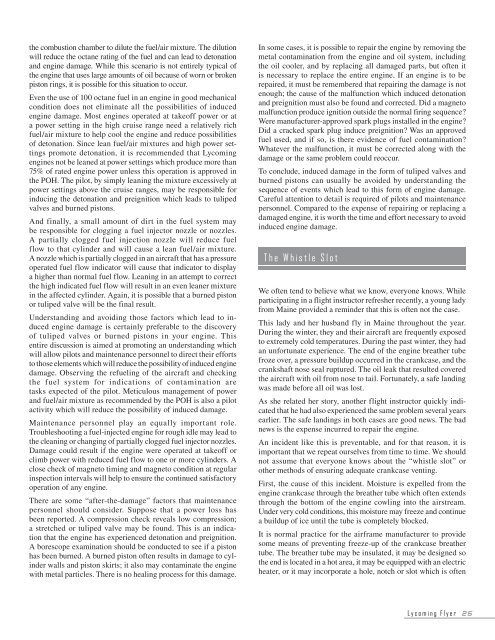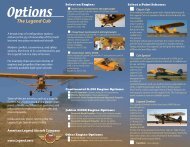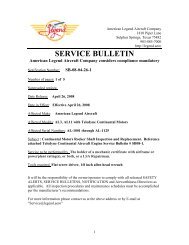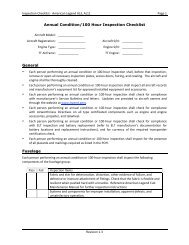Lycoming Flyer - Aircrafts sales, engines repair, spare parts
Lycoming Flyer - Aircrafts sales, engines repair, spare parts
Lycoming Flyer - Aircrafts sales, engines repair, spare parts
- No tags were found...
You also want an ePaper? Increase the reach of your titles
YUMPU automatically turns print PDFs into web optimized ePapers that Google loves.
the combustion chamber to dilute the fuel/air mixture. The dilutionwill reduce the octane rating of the fuel and can lead to detonationand engine damage. While this scenario is not entirely typical ofthe engine that uses large amounts of oil because of worn or brokenpiston rings, it is possible for this situation to occur.Even the use of 100 octane fuel in an engine in good mechanicalcondition does not eliminate all the possibilities of inducedengine damage. Most <strong>engines</strong> operated at takeoff power or ata power setting in the high cruise range need a relatively richfuel/air mixture to help cool the engine and reduce possibilitiesof detonation. Since lean fuel/air mixtures and high power settingspromote detonation, it is recommended that <strong>Lycoming</strong><strong>engines</strong> not be leaned at power settings which produce more than75% of rated engine power unless this operation is approved inthe POH. The pilot, by simply leaning the mixture excessively atpower settings above the cruise ranges, may be responsible forinducing the detonation and preignition which leads to tulipedvalves and burned pistons.And finally, a small amount of dirt in the fuel system maybe responsible for clogging a fuel injector nozzle or nozzles.A partially clogged fuel injection nozzle will reduce fuelflow to that cylinder and will cause a lean fuel/air mixture.A nozzle which is partially clogged in an aircraft that has a pressureoperated fuel flow indicator will cause that indicator to displaya higher than normal fuel flow. Leaning in an attempt to correctthe high indicated fuel flow will result in an even leaner mixturein the affected cylinder. Again, it is possible that a burned pistonor tuliped valve will be the final result.Understanding and avoiding those factors which lead to inducedengine damage is certainly preferable to the discoveryof tuliped valves or burned pistons in your engine. Thisentire discussion is aimed at promoting an understanding whichwill allow pilots and maintenance personnel to direct their effortsto those elements which will reduce the possibility of induced enginedamage. Observing the refueling of the aircraft and checkingthe fuel system for indications of contamination aretasks expected of the pilot. Meticulous management of powerand fuel/air mixture as recommended by the POH is also a pilotactivity which will reduce the possibility of induced damage.Maintenance personnel play an equally important role.Troubleshooting a fuel-injected engine for rough idle may lead tothe cleaning or changing of partially clogged fuel injector nozzles.Damage could result if the engine were operated at takeoff orclimb power with reduced fuel flow to one or more cylinders. Aclose check of magneto timing and magneto condition at regularinspection intervals will help to ensure the continued satisfactoryoperation of any engine.There are some “after-the-damage” factors that maintenancepersonnel should consider. Suppose that a power loss hasbeen reported. A compression check reveals low compression;a stretched or tuliped valve may be found. This is an indicationthat the engine has experienced detonation and preignition.A borescope examination should be conducted to see if a pistonhas been burned. A burned piston often results in damage to cylinderwalls and piston skirts; it also may contaminate the enginewith metal particles. There is no healing process for this damage.In some cases, it is possible to <strong>repair</strong> the engine by removing themetal contamination from the engine and oil system, includingthe oil cooler, and by replacing all damaged <strong>parts</strong>, but often itis necessary to replace the entire engine. If an engine is to be<strong>repair</strong>ed, it must be remembered that <strong>repair</strong>ing the damage is notenough; the cause of the malfunction which induced detonationand preignition must also be found and corrected. Did a magnetomalfunction produce ignition outside the normal firing sequence?Were manufacturer-approved spark plugs installed in the engine?Did a cracked spark plug induce preignition? Was an approvedfuel used, and if so, is there evidence of fuel contamination?Whatever the malfunction, it must be corrected along with thedamage or the same problem could reoccur.To conclude, induced damage in the form of tuliped valves andburned pistons can usually be avoided by understanding thesequence of events which lead to this form of engine damage.Careful attention to detail is required of pilots and maintenancepersonnel. Compared to the expense of <strong>repair</strong>ing or replacing adamaged engine, it is worth the time and effort necessary to avoidinduced engine damage.We often tend to believe what we know, everyone knows. Whileparticipating in a flight instructor refresher recently, a young ladyfrom Maine provided a reminder that this is often not the case.This lady and her husband fly in Maine throughout the year.During the winter, they and their aircraft are frequently exposedto extremely cold temperatures. During the past winter, they hadan unfortunate experience. The end of the engine breather tubefroze over, a pressure buildup occurred in the crankcase, and thecrankshaft nose seal ruptured. The oil leak that resulted coveredthe aircraft with oil from nose to tail. Fortunately, a safe landingwas made before all oil was lost.As she related her story, another flight instructor quickly indicatedthat he had also experienced the same problem several yearsearlier. The safe landings in both cases are good news. The badnews is the expense incurred to <strong>repair</strong> the engine.An incident like this is preventable, and for that reason, it isimportant that we repeat ourselves from time to time. We shouldnot assume that everyone knows about the “whistle slot” orother methods of ensuring adequate crankcase venting.First, the cause of this incident. Moisture is expelled from theengine crankcase through the breather tube which often extendsthrough the bottom of the engine cowling into the airstream.Under very cold conditions, this moisture may freeze and continuea buildup of ice until the tube is completely blocked.It is normal practice for the airframe manufacturer to providesome means of preventing freeze-up of the crankcase breathertube. The breather tube may be insulated, it may be designed sothe end is located in a hot area, it may be equipped with an electricheater, or it may incorporate a hole, notch or slot which is oftenL y c o m i n g F l y e r 2 5









